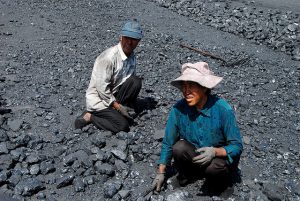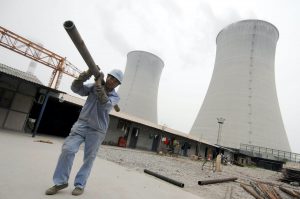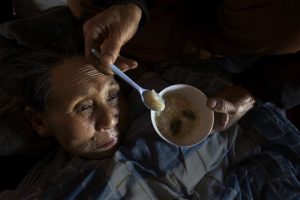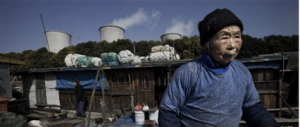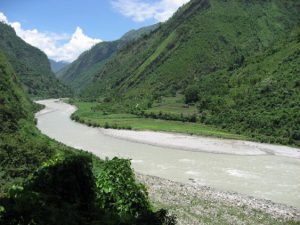The locals of Haoping, a township in the south of Shaanxi province, are known for their yellow teeth. The condition is even referred to as “Haoping Teeth”.
It isn’t just a cosmetic concern. Badly affected teeth often break and fall out. The scientific term for the condition is dental fluorosis, and in Haoping it’s caused by fluorine pollution from coal. “PM2.5 levels in rural areas are very high,” explains Tsinghua professor Yang Xudong. “We used to say that city air was bad, but it’s worse now in the countryside.” Rural energy habits, including the burning of coal, produce pollution which can also affect air quality in the cities, he adds.
Haoping’s economy is based on coal mining, but the local seams are high in fluorine. In the central and southern parts of the Qinba mountains, where Haoping is located, residents burn locally mined anthracite coal containing about 2,000 milligrammes of fluorine per kilogramme, according to 2005 figures from the provincial disease control office. This is 10 times the national average.
Data obtained by professor Wang Wuyi of the Chinese Academy of Sciences’ Institute of Geographic Sciences shows that in rural Shaanxi, fluorine levels inside homes were up to 97 times the permitted standard. Fluorine is among the harmful pollutants released from coal into the air and food, leading to chronic cumulative poisoning – the symptoms of which include dental and skeletal fluorosis.
Skeletal fluorosis has a graver impact on the lives of sufferers, as Yang Yunqin from the nearby village of Donguan explains: “Many of us suffer from leg pains once we reach 40 or 50.” Locals know that “Haoping folk have weak bones,” Yang adds. In severe cases, victims’ legs become deformed.
Figures from the China Centre for Disease Control (CDC) show that endemic fluorosis due to coal-burning is found in 14 of China’s provinces, affecting areas with a combined population of 33 million people.
The scale is so great because most kinds of coal in China produce fluorine above acceptable limits, regardless of how it is burned, according to professor Qi Qingjie of Liaoning Technical University. He has called for limits on fluorine compounds to be included in emissions standards for boilers – current regulations only limit smoke and dust, sulphur dioxides and nitrous oxides.
Fluorosis is not the only endemic disease caused by coal burning. A study of arsenic poisoning carried out in Shaanxi between 2001 and 2003 found that coal burned in the province contains up to 488.1 milligrammes of arsenic per kilogramme – almost five times the permitted level. Of 400 people examined, almost half had been affected.
Arsenic can cause a range of serious health problems in humans, including cancer and diseases of the central nervous system, as well as problems with eyesight, breathing, digestion, the metabolism and the urinary system. Cracked and damaged skin is also common.
Cases of arsenic poisoning linked to coal are mainly found in Guizhou and Shaanxi. The CDC has identified 38,000 cases in Guizhou. No full study has been carried out in the five counties affected in Shaanxi.
As the kind and quality of coal burned in China differs across regions, the health impacts also vary. But particulate matter, sulphur compounds, volatile organic compounds and heavy metals are commonly present and the damage these cause to health cannot be overlooked.
A study of domestic fuel use by Taiyuan University of Science and Technology found that 50-80% of the floating particular matter released from domestic stoves is under 2.5 microns in diametre – small enough to enter the lungs and blood – and high in polycyclic aromatic hydrocarbons, a human carcinogen.
The World Health Organization estimates that use of solid fuels (in particular coal rich in fluorine and sulphur) causes 400,000 premature deaths every year in rural China, mostly of women and children.
Problems replacing stoves
Almost everyone in Haoping has the same stove. Coal is burned in a cylindrical hole, about the width of a hand, dug into the concrete floor. Ash is swept into a larger, neighbouring pit. The ash-pit is usually covered with wood, while the mouth of the stove is left open.
In winter a family might spend the entire day around the stove, and in southern Shaanxi the stoves burn constantly from September to March. They have always been seen as a valuable and practical invention: in a dark home a family gathers around the glow of the stove, the heat warming the ground beneath their feet. But research has found these stoves to be dangerous – with no cover or chimney, the pollutants in the smoke are breathed in or settle on food, leading to fluorosis.
In 2004, the Chinese government started to promote the replacement of the traditional burners with new models, which cut indoor pollution.
Mrs Xu showed me her new stove. An iron cover had been set on the top, with a chimney jutting out from the side to carry the smoke away. Research has shown that these stoves are much more efficient and clean. Like in many homes, Mrs Xu’s upgrade was subsidised by the government. But despite the help on offer, some families in Haoping have opted not to buy the new stoves, or have made the purchase but not installed them.
One reason for this, says Li Yue, senior scientist with the provincial disease prevention authorities, is simply that it’s hard to change people’s habits. But in addition, the high sulphur content in the anthracite damages iron stoves and chimneys – “nobody wants to spend more money on repairs and replacement,” says Li.
Such policy failures have meant limited progress: “Although the incidence of fluorosis has fallen, it hasn’t gone down by much,” says Wang Wuyi.
In fact, greater mining and use of coal triggered an upsurge in fluorosis rates in southern Shaanxi at the end of the last century. In 1980, the provincial disease control office identified 10,000 sufferers of dental fluorosis and 5,000 adults with skeletal fluorosis in a population of almost 150,000 in Anding and Hanzhong in the Qinba mountains. In 2001, another study identified 1.13 million people living in affected areas, with almost 100,000 cases of adult skeletal fluorosis. Among the 140,000 eight- to 12-year-olds examined, almost 80,000 (57%) had dental fluorosis.
Increased mining of anthracite and better transportation, making the coal more likely to be burned elsewhere, was largely responsible for the spread of the disease, according to the provincial disease control office. And as China has returned farmland to forestry and fenced off hillsides to allow regeneration, rural households have been forced to buy in coal, rather than collect firewood.
Anthracite is still popular. One coal-transportation firm told me that it sells well despite being a poor quality coal. Some merchants mix it in with better fuel to reduce costs, and it is still used to make bricks.
Back in the village of Dongguan, some of the younger locals and those who have spent time in the cities use electricity for heat and cooking. Electric rice cookers and induction hobs are very popular. Even when they burn coal, the youngsters tend to prefer the newer, cleaner stoves that older generations reject.
But many rural residents will be using coal for years to come. Ten years ago, 30 million tonnes of coal were burned annually in rural areas of China, says professor Yang Xudong. Today, that figure is 190 million tonnes.
For many, the intimidating numbers mean the government must promote modern heating equipment more aggressively. Kirk Smith of the University of California, Berkley, an expert in coal and health issues says: “The simplest kind of coal stove you see, I don’t think it’s changed since Genghis Khan. This is the time to solve the problem.”
